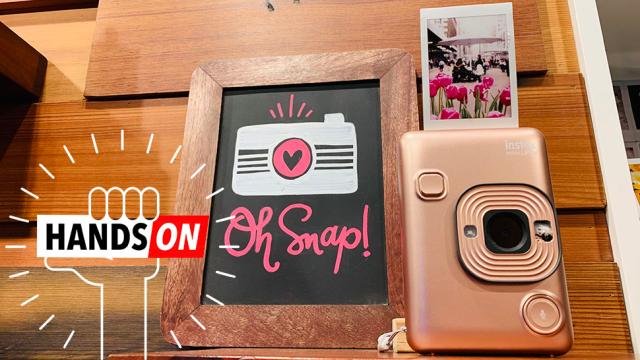Nostalgia sells—that’s abundantly clear when you look at how instant cameras went from rotting in a tech graveyard to gracing the shelves of seemingly every Urban Outfitters. Despite how far technology has come, instant cameras have stayed delightfully low-tech, for the most part. Fujifilm’s latest Instax Mini series camera, the LiPlay is probably the most advanced out there with Bluetooth, the ability to record audio, and print photos from your smartphone. Yet it also lets you choose which pics you take actually get printed. So is it even an instant camera?
Fujifilm is calling the Instax Mini LiPlay a “hybrid instant camera” and that makes sense when you finally get to handle one. On the back, there’s a 8cm colour LCD so you can save shots and give them a final review before printing. And after futzing around with the LiPlay, I’ve come to the conclusion the screen is a big reason why it doesn’t feel like using an instant camera.
Generally, instant cameras have a viewfinder because they lack LCD screens. It’s a tad inconvenient, but adds to the whole retro charm of the category. The LiPlay has no viewfinder. You compose and view all your shots via the screen. Also, since traditional instant cameras, well, print photos instantly, there’s no need for a memory card. You snap photos and that moment, good or bad, is what you get. Meanwhile, the LiPlay lets you store photos thanks to a microSD card slot.
You can take multiple shots without burning film and print exactly the one you want. Despite taking a dozen photos, I’ve only printed two—which makes this feel way more like a point and shoot with a printer attached than your typical instant camera.
The screen and microSD storage aren’t the only upgrades. The LiPlay features Bluetooth connectivity and has a companion app for both iOS and Android. That means you can do some interesting things like use your smartphone as a remote control for the shutter. It also means you can use the LiPlay to print photos from your camera roll. Fujifilm says it takes about 12 seconds to print, and that you can print up to 100 photos on a single charge.
Here’s where it starts to get a bit kooky. With the LiPlay, you can record 10-second audio clips while taking a photo—there’s a handy microphone button right under the shutter. Once you do that, the picture will print with a QR code and you can scan with your phone’s camera (Android users will have to download a separate QR reader app) to hear the clip. Who asked for this? I don’t know. I walked into the demo thinking the feature was going to be supremely stupid, but afterward, I felt like this could be a sweet feature. Say you take a photo of yourself, slap on a QR code for a clip of you saying “I love you!”, and give it to your mum so she can hear your voice whenever she misses you. (You’re welcome for next year’s Mother’s Day gift idea.)
Thanks to the LCD screen, you can also choose from 30 frames and six filters to add onto your photo…which sort of puts a knife through the main appeal of an instant camera? Sure they’re not as easy or convenient to use as a smartphone or digital camera, but the grainy, washed out look of old school Polaroids is what launched the whole filter craze. Part of the fun and artistry is not knowing how the film will develop.
The filters and frames feel like Fujifilm yanked Snapchat filters and stuffed them into an old school camera. Which, isn’t far off the mark. At the launch event, a Fujifilm executive described it to a roomful of journalists and Instagram influencers as “AR tech in analogue form.”
Which is maybe why the LiPlay feels weird—in a way that’s neither good nor bad. All the new tech makes this the ultimate instant camera for the Instagram generation. That’s also true when it comes to design—it’s the epitome of what you might expect an impeccably styled Instagram influencer to tote around. Right off the bat, I can see how adding the LCD screen and ability to review photos could remove one of the biggest pain points—wasting expensive film on borked photos. It also makes it so much easier to create hyper curated photos devoid of the imperfections that made instant cameras so charming.
That said, I appreciated just how small and lightweight the LiPlay is. If you can remember far back enough, it’s about the size of an old cassette recorder. You should be able to easily fit it into small bags or even baggy pockets. In terms of heft, it’s about the same weight as my iPhone XS Max—meaning this should be one of the easiest instant cameras to schlepp around.
I’ll have to spend more time with the LiPlay to see whether all these souped-up tech features change the overall instant camera experience. So far they do.
